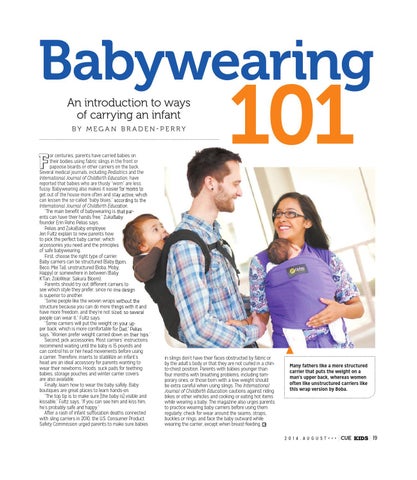Babywearing An introduction to ways of carrying an infant BY MEGA N BR ADEN-PERRY
F
or centuries, parents have carried babies on their bodies using fabric slings in the front or papoose boards or other carriers on the back. Several medical journals, including Pediatrics and the International Journal of Childbirth Education, have reported that babies who are thusly “worn” are less fussy. Babywearing also makes it easier for moms to get out of the house more often and stay active, which can lessen the so-called “baby blues,” according to the International Journal of Childbirth Education. “The main benefit of babywearing is that parents can have their hands free,” ZukaBaby founder Erin Reho Pelias says. Pelias and ZukaBaby employee Jen Fultz explain to new parents how to pick the perfect baby carrier, which accessories you need and the principles of safe babywearing. First, choose the right type of carrier. Baby carriers can be structured (Baby Bjorn, Beco, Mei Tai), unstructured (Boba, Moby, Happy) or somewhere in between (Baby K’Tan, ZoloWear, Sakura Bloom). Parents should try out different carriers to see which style they prefer, since no one design is superior to another. “Some people like the woven wraps without the structure because you can do more things with it and have more freedom, and they’re not sized, so several people can wear it,” Fultz says. “Some carriers will put the weight on your upper back, which is more comfortable for Dad,” Pelias says. “Women prefer weight carried down on their hips.” Second, pick accessories. Most carriers’ instructions recommend waiting until the baby is 15 pounds and can control his or her head movements before using a carrier. Therefore, inserts to stablilize an infant’s head are an ideal accessory for parents wanting to wear their newborns. Hoods, suck pads for teething babies, storage pouches and winter carrier covers are also available. Finally, learn how to wear the baby safely. Baby boutiques are great places to learn hands-on. “The top tip is to make sure [the baby is] visible and kissable,” Fultz says. “If you can see him and kiss him, he’s probably safe and happy.” After a rash of infant suffocation deaths connected with sling carriers in 2010, the U.S. Consumer Product Safety Commission urged parents to make sure babies
101
in slings don’t have their faces obstructed by fabric or by the adult’s body or that they are not curled in a chinto-chest position. Parents with babies younger than four months with breathing problems, including temporary ones, or those born with a low weight should be extra careful when using slings. The International Journal of Childbirth Education cautions against riding bikes or other vehicles and cooking or eating hot items while wearing a baby. The magazine also urges parents to practice wearing baby carriers before using them regularly; check for wear around the seams, straps, buckles or rings; and face the baby outward while wearing the carrier, except when breast-feeding.
Many fathers like a more structured carrier that puts the weight on a man’s upper back, whereas women often like unstructured carriers like this wrap version by Boba.
2014. AUGUST <<<
CUE KIDS 19
